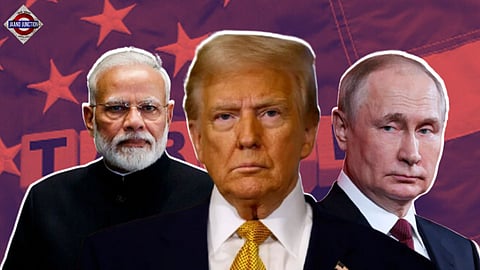

In a sharp rise in Indo-US trade tensions, Washington has sent a clear warning to New Delhi: expect more economic pain if the upcoming talks between US President Donald Trump and Russian President Vladimir Putin in Alaska fail.
US Treasury Secretary Scott Bessent, speaking to Bloomberg TV, said additional tariffs and sanctions could be imposed on India depending on the outcome of Friday’s high-profile meeting. The US has already doubled tariffs on Indian goods to 50% recently, citing India’s continued purchase of Russian oil despite Moscow’s war in Ukraine.
Key Players in This Story
Donald Trump – US President aiming to end the Ukraine war while pressuring countries trading with Russia.
Vladimir Putin – Russian President defending his country’s position and military actions.
Narendra Modi – Indian Prime Minister balancing international pressure with India’s energy needs and farmers’ interests.
Scott Bessent – US Treasury Secretary enforcing economic measures.
Volodymyr Zelenskyy – Ukrainian President urging India to support the global peace effort.
European Leaders – Urged by Washington to expand sanctions and share the economic burden.
How Tariffs Rose from 25% to 50%
The dispute began with Trump’s initial 25% tariff on Indian imports, a response to India’s ongoing Russian oil purchases. On August 7, Trump added another 25%, doubling the rate to 50%.
Trump accused India of “fueling the war machine” by indirectly funding Russia’s military through oil payments. India insists its imports are driven by market needs and energy security for its 1.4 billion people.
The Alaska Summit: A High-Stakes Meeting
Trump and Putin will meet on August 15, 2025, at the Elmendorf-Richardson military base in Anchorage, Alaska.
Time: 22:30 Moscow time (7:30 GMT / 1:00 am IST, August 16)
Format: Private talks, followed by meetings with senior advisers.
Outcome: Joint press conference expected.
The main topic is resolving the Ukraine conflict, now in its fourth year. Trump calls it a “feel-out session” to gauge Putin’s willingness for a ceasefire and has hinted at possible territorial changes—an idea Ukraine rejects.
Washington’s Strategy: Using Sanctions as Pressure
Bessent made it clear that tariffs serve as both punishment and leverage. He called on European countries to join in secondary sanctions, saying a united economic front is crucial to push Russia to end the war.
“The Europeans need to be willing to put on these secondary sanctions,” Bessent said, emphasizing the US is building “its own leverage” before the talks.
India’s Response and Pushback
India has called the tariffs “unfair, unjustified, and unreasonable.” Prime Minister Modi said he won’t sacrifice the interests of Indian farmers, even if it means economic fallout.
New Delhi also pointed to what it sees as double standards—countries criticizing India’s Russian oil imports while continuing their own trade with Moscow. The Ministry of External Affairs says its decisions are based on long-term energy needs and market factors, not politics.
Ukraine’s Stance and European Worries
President Zelenskyy insists no peace deal can happen without Ukraine’s direct involvement and vows not to give up any territory. European diplomats worry a behind-closed-doors Trump-Putin deal could favor Moscow and leave Ukraine sidelined.
What’s Next: Talks Hang in the Balance
US-India trade talks, stalled earlier this month, are set to resume on August 25—just two days before the 50% tariff takes full effect. But experts warn that India’s protection of its farm and dairy sectors remains a major hurdle.
If the Alaska summit fails, more tariffs and sanctions are likely, deepening the rift between Washington and New Delhi and threatening a key relationship in the Indo-Pacific.
For India, the next 48 hours could decide whether it weathers a short diplomatic storm or faces a longer period of economic trouble.
